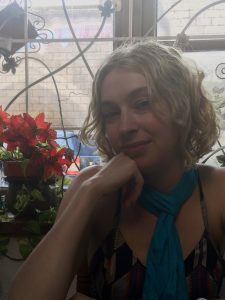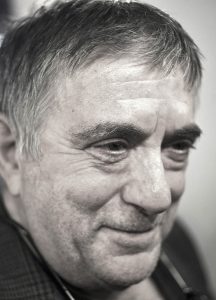— in conversation with Margaret Dragu and Paul Couillard
Margaret Dragu
Margaret works in video, installation, web/analogue publication & performance. Spanning relational, durational, interventionist and community-based practices, she has shown in Canada, USA & Europe. Dragu is celebrating her 50th year as working artist.Her favourite art-making material is still the body despite or because of her bionic status as a grateful owner of two recent hip replacements. She is a BCRPA Advanced Group Fitness & Yoga Instructor as well as Personal Trainer. She has 40+ years experience working with beginners, athletes, dancers, seniors and, is a Clinical Exercise & Post-Rehabilitation specialist. Margaret was the recipient of the Governor General’s Award for Visual and Media Arts in 2012, Éminence Grise (2012) for 7a*11d, and, in 2000, first artist in FADO’s publication series Canadian Performance Art Legends.
Paul Couillard
Paul Couillard has been working as a queer artist, curator, and performance art scholar since 1985. He has created well over 300 performance works in 26 countries, often with his husband and collaborator, Ed Johnson. Paul was the Performance Art Curator for FADO from 1993 until 2007, and is a founding co-curator of the 7a*11d International Festival of Performance Art. His main areas of interest include site-responsiveness, building community, and addressing trauma through explorations of our bodies as shared vessels of sensation, experience, knowledge and spirit. He is the editor of the monograph series Canadian Performance Art Legends, and has been a lecturer at McMaster University and the University of Toronto Scarborough. He recently completed a doctorate through the York Graduate Program in Communication and Culture. His dissertation Rethinking Presence with a Thinking Body: Intra-active Relationality and Animate Form offers a meditation on presence from the perspective of a thinking body, integrating insights from continental philosophy, popular neuroscience, and interactive performance art practices.
-
Margaret Dragu’s 1999 performance for the LIVE at the End of the Century cabaret
- Rebecca Belmore’s Manifesto (1999) which Paul is Referencing in his work Silence Number 8: Plumb-Lines with Thanks to Rebecca Belmore
- Joyce LeeAnn’s Archival Alchemy talk which Margret loves
- Naufus Ramirez-Figueroa, Paul Coulliard, Roco Trigueros and Francisco-Fernando Granados, Body Plural (aka the “sauna piece”) 2009:
- Additional footage from LIVE 2009
— in conversation with Rachel White and Fausto Grossi
Rachel White
 Rachel White is an artist based in Vancouver, BC, the unceded traditional territory of the Indigenous Peoples of the xʷməθkʷəy̓əm (Musqueam), Skwxwú7mesh (Squamish), and səl̓ilwətaɁɬ (Tsleil-Waututh) Nations. Informed by an interest in polyvagal theory, Rachel’s art practice seeks to activate the theoretical “social engagement system” within herself and others, providing reprieve for systems overfamiliar with long-term trauma responses: fight, flight, and freeze. Committed to her focus on co-regulation, collaboration, and sustainable communities, Rachel makes works of art with fellow NSCAD University graduates Dylan McHugh, Ian Prentice, and Leisha O’Donohue under the name DRIL Art Collective. In seeking contact with sundry nervous systems in a few alternate places, Rachel has also invested time working behind an espresso bar, dancing out late at underground music events, and gently parenting her pandemic-era toddler in and around their home in North Burnaby.
Rachel White is an artist based in Vancouver, BC, the unceded traditional territory of the Indigenous Peoples of the xʷməθkʷəy̓əm (Musqueam), Skwxwú7mesh (Squamish), and səl̓ilwətaɁɬ (Tsleil-Waututh) Nations. Informed by an interest in polyvagal theory, Rachel’s art practice seeks to activate the theoretical “social engagement system” within herself and others, providing reprieve for systems overfamiliar with long-term trauma responses: fight, flight, and freeze. Committed to her focus on co-regulation, collaboration, and sustainable communities, Rachel makes works of art with fellow NSCAD University graduates Dylan McHugh, Ian Prentice, and Leisha O’Donohue under the name DRIL Art Collective. In seeking contact with sundry nervous systems in a few alternate places, Rachel has also invested time working behind an espresso bar, dancing out late at underground music events, and gently parenting her pandemic-era toddler in and around their home in North Burnaby.
Fausto Grossi
 Fausto Grossi was born in Italy in 1954. He grew up around magazines, newspapers, comics in the family newsstand, in Arce, a village in the countryside of Ciociaria between Rome and Naples. This aroused his curiosity in the necessity to learn, and live a full and passionate life.
Fausto Grossi was born in Italy in 1954. He grew up around magazines, newspapers, comics in the family newsstand, in Arce, a village in the countryside of Ciociaria between Rome and Naples. This aroused his curiosity in the necessity to learn, and live a full and passionate life.
He traveled, and is still traveling, to discover the essence of life through human relationships; to get to know others and know himself through them. He lives a life in which art occupies a decisive place; where it’s failure means learning. Since 1992, Fausto has lived in Bilbao with his whole family. There he works as “pizzaiolo” and “pastaio” in his family shop, Pasta y Pizza Grossi, which shares a place with Spazio Grossi. Pasta and Pizza Grossi with Spazio Grossi is a place of gathering devoted to art and culture, including collaborations with ex!poesía (triennial of experimental poetry of Basque Country) and M.E.M. Festival. Fausto’s art practice includes cooking, sharing and making evident things of daily life that normally go unnoticed. Art for him is like breathing, it is something natural, something he needs to live, to feel alive and to be what he is: a human being.
- Fausto Grossi in Secret Chef on ETB-2
- Additional footage from LIVE 2015
— in conversation with Daina Warren and Peter Morin
Peter Morin
Peter Morin is a grandson of Tahltan Ancestor Artists. Morin’s artistic offerings can be organized around four themes: articulating Land/Knowing, articulating Indigenous Grief/Loss, articulating Community Knowing, and understanding the Creative Agency/Power of the Indigenous body. The work takes place in galleries, in community, in collaboration, and on the land. All of the work is informed by dreams, Ancestors, Family members, and performance art as a research methodology. Morin began art school in 1997, completing his Bachelor of Fine Arts at Emily Carr Institute of Art and Design in Vancouver in 2001 and his Masters in Fine Arts in 2010 at the University of British Columbia-Okanagan. Initially trained in lithography, Morin’s artistic practice moves from printmaking to poetry to installation to performance art. Morin’s first performance ‘I grieve too much’ took place at the Museum of Anthropology in 2005. Peter is the son of Janelle Morin (Crow Clan, Tahltan Nation) and Pierre Morin (Quebecois). Throughout his exhibition and making history, Morin has focused upon his matrilineal inheritances in homage to the matriarchal structuring of the Tahltan Nation, and prioritizes Cross-Ancestral collaborations. Morin was longlisted for the Brink and Sobey Awards, in 2013 and 2014, respectively. In 2016, Morin received the Hnatyshyn Foundation Award for Outstanding Achievement by a Canadian Mid-Career Artist. Morin currently holds a tenured appointment in the Faculty of Arts at the Ontario College of Art and Design University in Toronto, and is the Graduate Program Director of the Interdisciplinary Master’s in Art, Media and Design program at OCADU.
Daina Warren
Daina Warren is from the Akamihk (Cree) Nation in Maskwacis (Bear Hills), AB. She was awarded two Canada Council’s Aboriginal Curatorial Residencies the first to work with grunt gallery, Vancouver BC (2000-2001) and a second residency at the National Gallery of Canada in Ottawa, Ontario (2010-2011). She has a BFA from the Emily Carr University of Art and Design (2003) and an MA from UBC (2012). Warren was awarded the 2015 Emily Award from Emily Carr University and was selected as one of six Indigenous women curators as part of the Canada Council for the Arts Delegation to participate in the International First Nations Curators Exchange that took place in Australia (2015), New Zealand (2016), and Canada (2017). Her most recent accomplishment was winning the Hnatyshyn Foundation Award for Curatorial Excellency in 2018. She is currently the Director of Urban Shaman Contemporary Aboriginal Art in Winnipeg, Manitoba.
- Documentation of piece of Peter Morin’s In Order to Contemplate the Making (2009)
- John Boehme’s 1999 LIVE at the End of the Century Cabaret Performance
- grunt gallery’s INDIANacts: https://indianacts.gruntarchives.org/index.html
- Peter Morin’s “12 Making Objects: 12 Indigenous interventions a.k.a First Nation’s DADA”
- Additional footage from LIVE 2009
